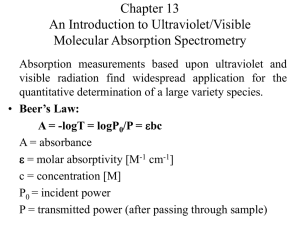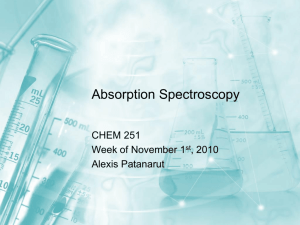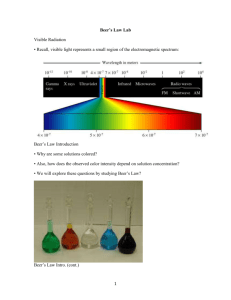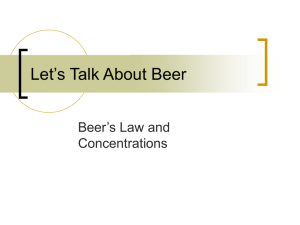Chapter 18 Let there be light
advertisement
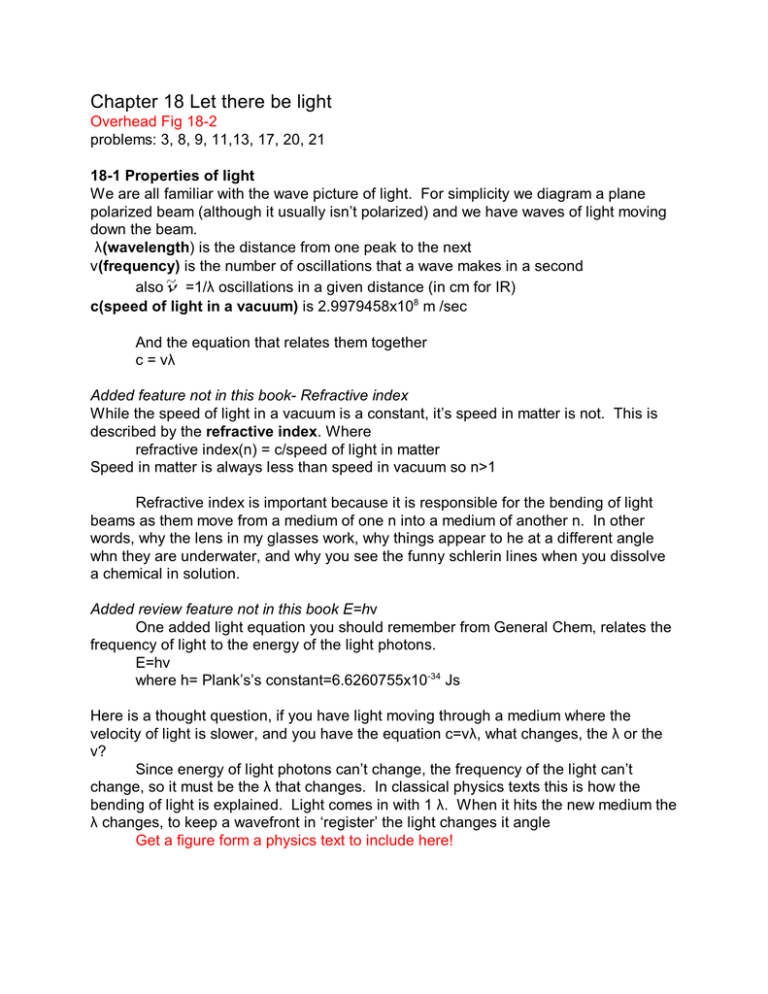
Chapter 18 Let there be light Overhead Fig 18-2 problems: 3, 8, 9, 11,13, 17, 20, 21 18-1 Properties of light We are all familiar with the wave picture of light. For simplicity we diagram a plane polarized beam (although it usually isn’t polarized) and we have waves of light moving down the beam. 8(wavelength) is the distance from one peak to the next <(frequency) is the number of oscillations that a wave makes in a second also =1/8 oscillations in a given distance (in cm for IR) c(speed of light in a vacuum) is 2.9979458x108 m /sec And the equation that relates them together c = <8 Added feature not in this book- Refractive index While the speed of light in a vacuum is a constant, it’s speed in matter is not. This is described by the refractive index. Where refractive index(n) = c/speed of light in matter Speed in matter is always less than speed in vacuum so n>1 Refractive index is important because it is responsible for the bending of light beams as them move from a medium of one n into a medium of another n. In other words, why the lens in my glasses work, why things appear to he at a different angle whn they are underwater, and why you see the funny schlerin lines when you dissolve a chemical in solution. Added review feature not in this book E=h< One added light equation you should remember from General Chem, relates the frequency of light to the energy of the light photons. E=h< where h= Plank’s’s constant=6.6260755x10-34 Js Here is a thought question, if you have light moving through a medium where the velocity of light is slower, and you have the equation c=<8, what changes, the 8 or the <? Since energy of light photons can’t change, the frequency of the light can’t change, so it must be the 8 that changes. In classical physics texts this is how the bending of light is explained. Light comes in with 1 8. When it hits the new medium the 8 changes, to keep a wavefront in ‘register’ the light changes it angle Get a figure form a physics text to include here! 2 Before we leave this introduction you should also be reminded of the electromagnetic spectrum (Figure 18-2) Long wavelength- low energy, short wavelength - high energy X-ray ionize molecules UV moved electrons around in molecular orbitals Infrared - Vibrates molecules Microwave - rotates molecules 18-2 Absorption of light Light doesn’t just pass through matter, it interacts with it. That is why it slows down in matter. Before a molecule interacts with light it is said to be in the ground state. If light energy interacts with a molecule it puts energy into the molecule and promotes it to an excited state. In table 18-2 is an indication of what form that excitation may mean. In the microwave region it raises makes the molecules rotate thus healing up you zapped coffee in the morning. At the other extreme, I (X-ray) it can make molecules ionize and become very reactive. If light interacts with matter and transfers some energy to it, then the light itself losses energy. This is measured by analyzing the radiant power of the light beam. Transmittance(T)= P/Po where P is the measured power after the absorbance and Po is the original power. You can see that T<1 it is usually given as % transmittance. It is easy to understand Transmittance, the fraction of light making it through a sample, but using this number directly in chemical calculations is difficult, and I will show you why. Let’s say we have a sheet of plastic that absorbs half the light coming from on our light source. If we start with 1 unit of light, then, after the light gets through the sample, only .5 units are left. Now lets put another sheet of this plastic in the beam how much light makes it through now? .25. Another .125, etc. You can see that for each sheet of plastic the beam gets lowered by 50% 3 This should look to you like an exponential decay, and it is. As an exponential decy it is a little unhandy to use directly in an equation because it is not linear. How do we make it linear? Take the log of the function Y = log(T) And since I don’t like using negative numbers, let’s take the negative of the Y = -log(T) We now see that -log(T) is directly proportional to the pathlength, (this distance the light travels through the absorbing material. -log(T)% pathlength Now let’s deal with concentration. Lets fill a 1 cm cell with a concentration of material that will absorb ½ of the light to or T is .5. Now let’s try a thought experiment. Let’s imagine that all the light absorbing molecules get shuffled to the from ½ of the cell; the concentration in the front half of the cell is 2 times what it was, and the light level ½ way through the cell is .5. Add more molecules to the back half of the cell so the concentration matches the front half How much light get through this back half? .5 of .5 =.25. 4 Play this game a few more times [Conc] light 1 .5 2 .25 4 .125 And you get exactly the same thing we say for pathlegnth -log(T) % concentration This brings us to the concept of Absorbance (A) A=log10(Po/P) = -logT When no light is absorbed T=100% and A=0 When 90% of the light is absorbed T=10% A=1. When 99% of the light is absorbed T=1%, and A=2 As you have just seen, absorbance is useful because it can be directly related to the concentration of a species and pathlength. This relationship was put into Beer’s Law A=,bc where , is a proportionality constant called the extinction coefficient or molar absorptivity b=pathlength in cm and C is concentration in moles/liter Let’s try some example calculations What is the absorbance of a 1x10-4M solution for a compound with a molar absorptivity of 2.0x103 M-1cm-1 in a 1 cm cell? What is the transmittance of the solution? A = ,lc = 2x103(1)1x10-4 =.2 A = -log(T) .2=-log(T) -.2=log(T) 10-.2 =T T=.631 or 63% A 1.5x10-6 M solution in a 5 cm cell has a 20% transmittance. What is the molar absorptivity of this substance? 5 T=.2 A = -logT A=-log(.2) A=.70 .70 = ,(5)1.5x10-6 ,=.7/(5x1.5x10-6) =93,999 M-1cm-1 Note this is a chemistry text so they only use moles/liter. Also note that , is a function of wavelength. It can vary widely, being 0 at one wavelength and may be 3,330 at another nearby. A plot of , vs 8 is called an absorption spectrum The light energy is absorbed by a portion of the molecule, called a chromophore that undergoes an electronic transition. That is the electrons in one orbital are move into an orbital with a higher energy. In this class we will use Beer’s law frequently to find the concentration of a substance. You should remember that there are cases where Beer’s law fails 1. As a solution becomes more concentrated than .01M the molecules begin to interact with each other, changing the way the interact with light, thus Beer’s law may fail at high concentrations 2. Beer’s law assumes that each molecule is dissolved in solution and the only way light interacts with matter is through absorption. But what if solution is cloudy or has a precipitate?? Then the light is being reflected off the substance in solution and Beer’s law fail again 3. Once a molecule absorbs light, it may emit it as fluorescence or phosphorescence as well. This also ruins Beer’s law. (But you can build very sensitive measuring techniques around it. 4. the light may actually perform a chemical reaction in the molecule The spectrophotometer This simplest spectrophotometer (a spec 20) looks like this Light Source -- Monochrometer–Sample–detector. --The light source can be as simple as a light bulb. --The monochrometer is a slit, a prism or grating to disperse the light into a spectrum, and a second slit to chose a small range of the spectrum to pass to the sample --The detector is a phototube that gives a different voltage with different amounts of 6 light hitting it. Since the light source does not give off all wavelengths of light evenly and the detector is not as sensitive to all wavelengths of light in the same way, such an instrument must be calibrate every time you change the monochrometer setting (Do you remember doing this in the lab?) We will talk about other spectrometer designs in the next chapter Some precautions to think about 1. Simple Spectrometers (like the spec 20) are most accurate in the range of 0.40.9.If you absorbance falls outside this range you might have problems (Fancier ones, like the lambda 2 are better .05-1.5) 2. Cloudy samples don’t measure correctly (See discussion of Beer’s law above) 3. For sensitive measurement you should have well matched cells and make sure the cells are placed in the instrument in exactly the same way throughout an experiment. 18-3 Practical Matters Already had the simplest design for a instrument. How do you hold the sample? A cell or cuvette My be cylindrical or rectangular, large or small volume If working in UV windows must be quartz (crystalline SiO2) or fused silica (SiO2 glass). Regular glass or plastic won’t work because they absorb UV light If working in visible quartz, fused silica, glass or plastic work (Use plastic in lab because cheaper the quartz cells are about $50) If in IR need other crystals NaCl and KBr are cheapest, but what happens with water? (They dissolve) so need other crystals for aqueous work Good Operating technique Cuvet must be clean! Especially the windows You don’t know how many curses are muttered under my breath when I find dirty cuvets left after somebody has used a machine Slight mismatches between cuvets can introduce systematic errors, always use matched pairs Machine are most accurate in .4 to .9 range so usually try to target that 7 concentration Double beam instruments like the machine like the lambda-2 are accurate over a much broader range, easily .05 to 1.5 Always work at an absorbance max. Give most sensitive readings and results won’t vary if the wavelength drifts a bit 18-4 Using Beer’s Law Often you will find that you can’t look up the , of a substance. Then what do you do? You make a standard curve, just like we did in the lab. Plot absorbance vs [ ] and use to determine unknown. Here is where you finally get to use the line of best fit equations you had in the early chapters.

